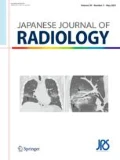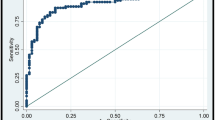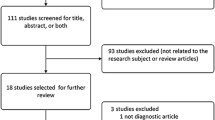Abstract
Purpose
We evaluated the diagnostic performance of elastography and tissue quantification using acoustic radiation force impulse (ARFI) technology for differential diagnosis of breast masses.
Materials and methods
There were 161 mass lesions. First, lesion correspondence on ARFI elastographic images to those on the B-mode images was evaluated: no findings on ARFI images (pattern 1), lesions that were bright inside (pattern 2), lesions that were dark inside (pattern 4), lesions that contained both bright and dark areas (pattern 3). In addition, pattern 4 was subdivided into 4a (dark area same as B-mode lesion) and 4b (dark area larger than lesion). Next, shear wave velocity (SWV) was measured using virtual touch tissue quantification.
Results
There were 13 pattern 1 lesions and five pattern 2 lesions; all of these lesions were benign, whereas all pattern 4b lesions (n = 43) were malignant. When the value of 3.59 m/s was chosen as the cutoff value, the combination of elastography and tissue quantification showed 91 % (83–91) sensitivity, 93 % (65–70) specificity, and 92 % (148–161) accuracy.
Conclusion
The combination of elastography and tissue quantification is thought to be a promising ultrasound technique for differential diagnosis of breast-mass lesions.








Similar content being viewed by others
References
Stavros AT, Thickman D, Rapp CL, Dennis MA, Parker SH, Sisney GA. Solid breast nodules: use of sonography to distinguish between benign and malignant lesions. Radiology. 1995;196(1):123–34.
Zonderland HM, Coerkamp EG, Hermans J, van de Vijver MJ, van Voorthuisen AE. Diagnosis of breast cancer: contribution of US as an adjunct to mammography. Radiology. 1999;213(2):413–22.
Flobbe K, Nelemans PJ, Kessels AG, Beets GL, von Meyenfeldt MF, van Engelshoven JM. The role of ultrasonography as an adjunct to mammography in the detection of breast cancer. A systematic review. Eur J Cancer. 2002;38(8):1044–50.
Itoh A, Ueno E, Tohno E, Kamma H, Takahashi H, Shiina T, et al. Breast disease: clinical application of US elastography for diagnosis. Radiology. 2006;239(2):341–50.
Tardivon A, El Khoury C, Thibault F, Wyler A, Barreau B, Neuenschwander S. Elastography of the breast: a prospective study of 122 lesions. J Radiol. 2007;88(5):657–62.
Wojcinski S, Farrokh A, Weber S, Thomas A, Fischer T, Slowinski T, et al. Multicenter study of ultrasound real-time tissue elastography in 779 cases for the assessment of breast lesions: improved diagnostic performance by combining the BI-RADS®-US classification system with sonoelastography. Ultraschall Med. 2010;31(5):484–91.
Raza S, Odulate A, Ong EM, Chikarmane S, Harston CW. Using real-time tissue elastography for breast lesion evaluation: our initial experience. J Ultrasound Med. 2010;29(4):551–63.
Yoon JH, Kim MH, Kim EK, Moon HJ, Kwak JY, Kim MJ. Interobserver variability of ultrasound elastography: how it affects the diagnosis of breast lesions. Am J Roentgenol. 2011;196(3):730–6.
Meng W, Zhang G, Wu C, Wu G, Song Y, Lu Z. Preliminary results of acoustic radiation force impulse (ARFI) ultrasound imaging of breast lesions. Ultrasound Med Biol. 2011;37(9):1436–43.
Tozaki M, Isobe S, Yamaguchi M, Ogawa Y, Homma K, Saito M, et al. Ultrasonographic elastography of the breast using acoustic radiation force impulse technology: preliminary study. Jpn J Radiol. 2011;29(6):452–6.
Tozaki M, Isobe S, Fukuma E. Preliminary study of ultrasonographic tissue quantification of the breast using the acoustic radiation force impulse (ARFI) technology. Eur J Radiol. 2011;80(2):e182–7.
Nightingale K, Soo MS, Nightingale R, Trahey G. Acoustic radiation force impulse imaging: in vivo demonstration of clinical feasibility. Ultrasound Med Biol. 2002;28(2):227–35.
Zhai L, Palmeri ML, Bouchard RR, Nightingale RW, Nightingale KR. An integrated indenter-ARFI imaging system for tissue stiffness quantification. Ultrason Imaging. 2008;30(2):95–111.
American College of Radiology (ACR). ACR BI-RADS-mammography, 4th edn. In: ACR breast imaging reporting and data system. Reston, VA: American College of Radiology; 2003.
American College of Radiology (ACR). ACR BI-RADS-US, 1st ed. In: ACR Breast imaging reporting and data system. Reston, VA: American College of Radiology, 2003.
Abdullah N, Mesurolle B, El-Khoury M, Kao E. Breast imaging reporting and data system lexicon for US: interobserver agreement for assessment of breast masses. Radiology. 2009;252(3):665–72.
Japanese Breast Cancer Society. General rules for clinical and pathological recording of breast cancer. 15th ed. Tokyo: Japanese Breast Cancer Society; 2004.
Garra BS, Cespedes EI, Ophir J, Spratt SR, Zuurbier RA, Magnant CM, et al. Elastography of breast lesions: initial clinical results. Radiology. 1997;202(1):79–86.
Tozaki M, Saito M, Joo C, Yamaguchi M, Isobe S, Ogawa Y, et al. Ultrasonographic tissue quantification of the breast using acoustic radiation force impulse technology: phantom study and clinical application. Jpn J Radiol. 2011;29(8):598–603.
Kim EK, Ko KH, Oh KK, Kwak JY, You JK, Kim MJ, et al. Clinical application of the BI-RADS final assessment to breast sonography in conjunction with mammography. Am J Roentgenol. 2008;190(5):1209–15.
Costantini M, Belli P, Lombardi R, Franceschini G, Mulè A, Bonomo L. Characterization of solid breast masses: use of the sonographic breast imaging reporting and data system lexicon. J Ultrasound Med. 2006;25(5):649–59.
Heinig J, Witteler R, Schmitz R, Kiesel L, Steinhard J. Accuracy of classification of breast ultrasound findings based on criteria used for BI-RADS. Ultrasound Obstet Gynecol. 2008;32(4):573–8.
Raza S, Chikarmane SA, Neilsen SS, Zorn LM, Birdwell RL. BI-RADS 3, 4, and 5 lesions: value of US in management–follow-up and outcome. Radiology. 2008;248(3):773–81.
Acknowledgments
The study was supported by Masahiro Saito, Yoshihiko Nomi and Chanwoong Joo (Mochida Siemens Medical Systems Co., Ltd, Tokyo, Japan), and we greatly appreciate their help.
Conflict of interest
None.
Author information
Authors and Affiliations
Corresponding author
About this article
Cite this article
Tozaki, M., Isobe, S. & Sakamoto, M. Combination of elastography and tissue quantification using the acoustic radiation force impulse (ARFI) technology for differential diagnosis of breast masses. Jpn J Radiol 30, 659–670 (2012). https://doi.org/10.1007/s11604-012-0106-3
Received:
Accepted:
Published:
Issue Date:
DOI: https://doi.org/10.1007/s11604-012-0106-3




